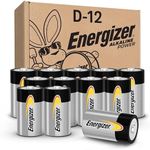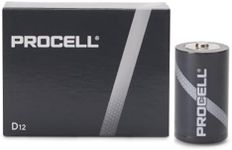Buying Guide for the Best D Batteries
When it comes to picking the right D batteries, it's important to understand the key specifications that will ensure you get the best performance for your needs. D batteries are commonly used in high-drain devices like flashlights, radios, and large toys. Knowing what to look for can help you make an informed decision and ensure your devices run efficiently and for as long as possible.Battery ChemistryBattery chemistry refers to the materials used inside the battery to store and release energy. The most common types are alkaline, lithium, and rechargeable (NiMH). Alkaline batteries are widely available and offer good performance for most applications. Lithium batteries are more expensive but provide longer life and better performance in extreme temperatures. Rechargeable NiMH batteries can be reused many times, making them cost-effective and environmentally friendly. Choose alkaline for general use, lithium for high-drain or extreme conditions, and rechargeable if you use batteries frequently.
Capacity (mAh)Capacity, measured in milliampere-hours (mAh), indicates how much energy the battery can store. Higher capacity means the battery will last longer before needing replacement or recharging. Alkaline D batteries typically have a capacity of around 12,000 to 18,000 mAh, while rechargeable NiMH batteries range from 8,000 to 10,000 mAh. For devices that require long-lasting power, such as flashlights or radios, opt for batteries with higher capacity. For less demanding devices, a lower capacity may suffice.
Shelf LifeShelf life is the duration a battery can be stored before it starts to lose its charge. Alkaline batteries usually have a shelf life of 5 to 10 years, while lithium batteries can last up to 20 years. Rechargeable batteries have a shorter shelf life, typically around 3 to 5 years. If you need batteries for emergency use or infrequent use, choose ones with a longer shelf life to ensure they are ready when you need them.
Operating Temperature RangeThe operating temperature range indicates the temperatures at which the battery can function effectively. Alkaline batteries perform well in moderate temperatures but may struggle in extreme cold or heat. Lithium batteries excel in a wider range of temperatures, making them ideal for outdoor or high-temperature applications. Rechargeable batteries generally perform well in moderate conditions but may not be suitable for extreme environments. Consider where and how you will use the batteries to choose the right type for your needs.
Environmental ImpactEnvironmental impact refers to the ecological footprint of the battery, including its production, use, and disposal. Alkaline batteries are disposable and can contribute to landfill waste, though some are recyclable. Lithium batteries also have disposal concerns but offer longer life, reducing the frequency of replacement. Rechargeable batteries are the most environmentally friendly option as they can be reused many times, reducing waste. If environmental impact is a concern for you, opt for rechargeable batteries and ensure proper recycling of all battery types.





















